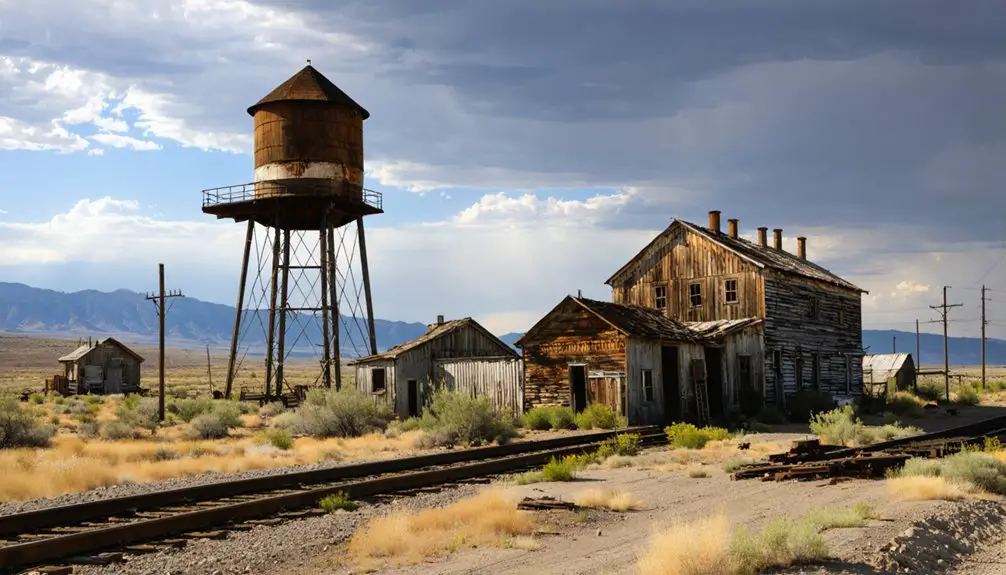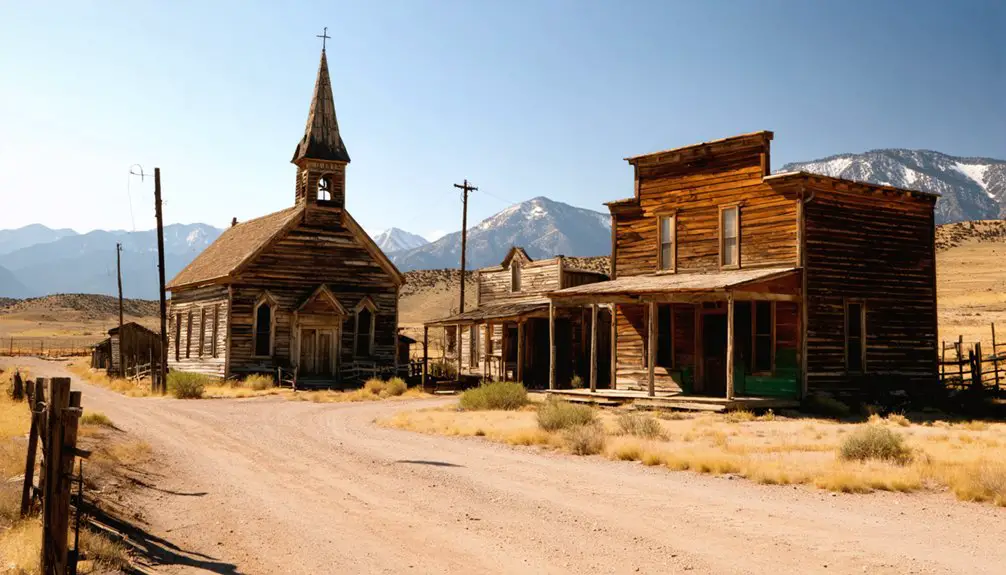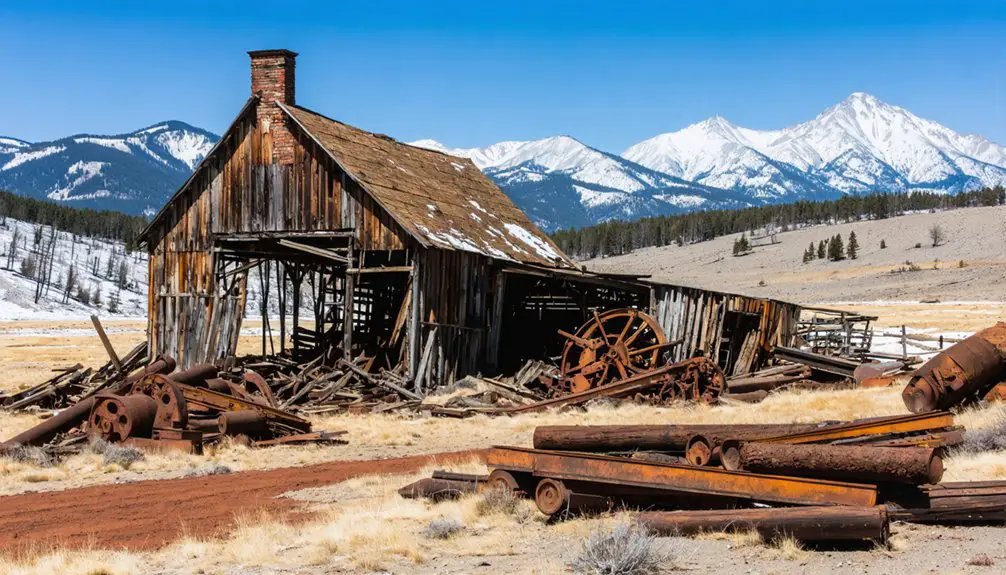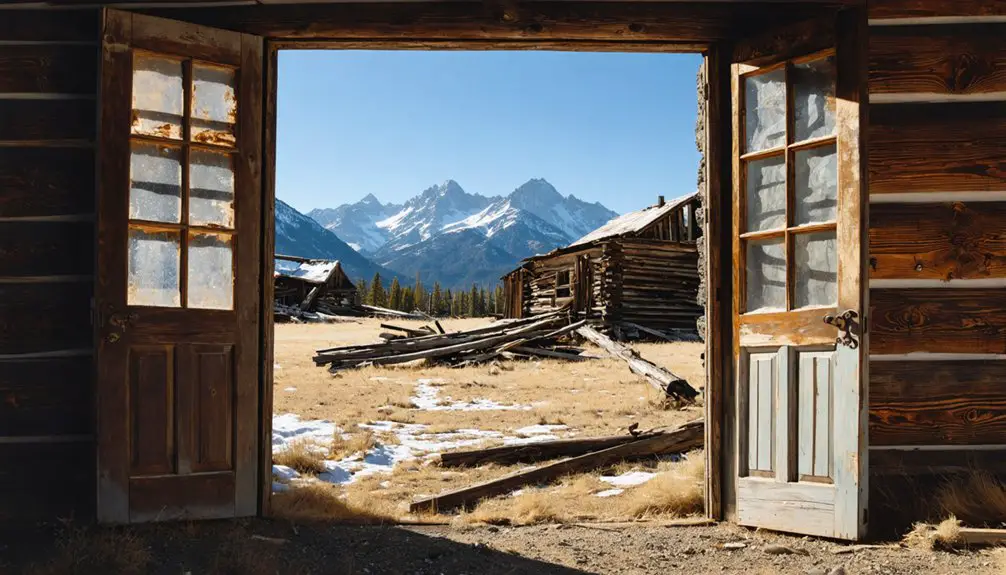You’ll discover Blacks Fork, a ghost town near the Wyoming border that played an essential role in America’s railroad expansion during the 1870s-1900s. This remote timber outpost supplied over 9 million railroad ties to the Union Pacific Railroad through innovative transport systems and the hard work of 50-100 lumbermen who called it home. The town’s remaining duplex cabins and commissary hint at a fascinating story of frontier industry and community life.
Key Takeaways
- Blacks Fork was a thriving 1870s timber town near the Wyoming border that supplied railroad ties to the Transcontinental Railroad.
- The town’s peak population reached 50-100 men, housed in duplex-style cabins with a central commissary for supplies.
- By 1913, Blacks Fork had supplied over 9 million railroad ties to Union Pacific Railroad before declining.
- Workers endured seasonal labor cycles, moving between mountain forests in summer and lower elevations in winter.
- Today, the abandoned site faces environmental challenges including mine contamination and forest fire damage to surrounding areas.
A Timber Town’s Birth in the Mountains
Three key factors drove the birth of Blacks Fork in the 1870s: the booming demand for timber, its strategic location near the Wyoming border, and the needs of the expanding railroad industry.
You’ll find Blacks Fork’s origins deeply rooted in the timber supply business, as contractors established this company town to support operations on the Uinta Mountains’ northern slope.
Located just 1.5 miles from Wyoming near Blacks Fork of the Green River, the settlement emerged as a crucial hub for lumber production.
The town’s strategic position made it ideal for serving multiple industries, from railroad construction to mining operations.
As a government commissary post, it supplied local laborers while supporting the region’s expanding infrastructure needs. At its peak, the bustling outpost housed an estimated 50 to 100 men who worked tirelessly in the timber industry.
The settlement’s foundation reflected the era’s robust industrial growth and resource development. The town became particularly important after 1913 when Swedish immigrants began arriving as professional tie cutters.
Life in a Remote Lumber Community
You’d find the daily life of Blacks Fork’s lumber workers revolving around intense physical labor, as they wielded axes and worked with horses to harvest timber before the arrival of portable sawmills in the 1930s.
During the harsh mountain winters, workers adapted by using the icy ground to their advantage for dragging heavy logs, while taking shelter in company-provided housing that served as a buffer against the extreme conditions.
The commissary acted as the heart of this remote community, where workers not only obtained their essential supplies but also found a gathering place for social interaction away from the isolation of their logging duties. The community’s close proximity to the Transcontinental Railroad made it easier for workers to transport their timber products efficiently to distant markets. The town’s peak population of 50 to 100 lumbermen demonstrated the significant workforce needed to sustain the local timber industry.
Daily Worker Routines
Life in Blacks Fork revolved around the demanding rhythms of lumber production, with workers facing intense physical labor from dawn to dusk. Your typical day would start early, heading into the vast timber stands where you’d spend hours selecting and felling large-diameter trees using axes and, later, chainsaws. Like creating a member profile, logging records were carefully maintained for each worker.
The lumber was vital for railroad tie demands, making Blacks Fork’s location near the Transcontinental Railroad strategically important.
Worker routines shifted with the seasons – you’d move deep into the mountains during summer months for cutting, then return to town in winter.
As a tie cutter, you’d navigate rugged terrain while implementing various logging techniques, from dragging logs over ice to operating the more efficient log flumes.
You’d make regular trips to the commissary for supplies and end your day in company housing, sharing the remote settlement with 50-100 fellow workers who understood the challenges of this isolated but essential trade.
Living Through Harsh Winters
The harsh winter months in Blacks Fork brought an entirely different set of challenges to the lumber community’s daily routines. You’d find yourself facing subzero temperatures and several feet of snow, requiring careful winter survival preparation.
Workers stockpiled firewood and provisions at the company commissary, knowing they’d be cut off from outside access for months. The timber company operations continued until the 1930s before finally shutting down permanently.
You’d layer up in wool and leather clothing while sheltering in insulated cabins heated by wood stoves. The isolation struggles were real – you couldn’t communicate with nearby towns, and medical help was scarce. The community relied on quaking-asp trees for their dependable firewood supply.
Yet the frozen ground offered one advantage: you could more easily transport heavy logs by sled. When storms hit, you’d halt operations and hunker down, relying on stored supplies and community support to endure the brutal mountain winters.
Community Social Dynamics
Social bonds in Blacks Fork emerged from a distinctive male-dominated community of 50 to 100 lumbermen and tie cutters, all operating under the timber company’s oversight.
You’d find worker camaraderie developing naturally through shared labor challenges, dangerous conditions, and isolation in the remote mountain forests.
The commissary served as your primary gathering spot, where you’d trade stories and supplies with fellow workers.
Seasonal migration shaped these relationships – you’d form tight bonds during summer logging months, then scatter for winter.
Without formal institutions, your social life centered entirely around work schedules and company facilities.
The transient nature of logging work meant you’d rarely put down permanent roots, but you’d find strength in the collective experience of timber work and mutual support among your fellow lumbermen.
The duplex style cabins housed single workers, reflecting the community’s bachelor-focused living arrangements.
Peak Years of Prosperity
During its heyday from the 1870s through the early 1900s, Blacks Fork thrived as a bustling timber industry outpost, housing between 50 to 100 lumbermen who worked tirelessly to meet the region’s insatiable demand for railroad ties and mining materials.
The economic impact of the town’s operations rippled throughout the Rocky Mountain region, fueled by the strategic location near the Transcontinental Railroad. Local workers focused heavily on producing charcoal for building to meet growing industrial needs.
The Transcontinental Railroad’s proximity turned Blacks Fork into an economic powerhouse, spreading prosperity across the Rocky Mountains.
You’ll find evidence of the town’s prosperity in several key aspects:
- Multiple duplex-style cabins served as boarding houses for the workforce
- A government commissary post supplied essential goods to workers and families
- Large barns with horse stalls supported year-round logging operations
- Timber companies’ capital investments drove construction and sustainability
The town’s peak years showcased the remarkable synergy between railroad expansion, mining operations, and timber production.
The Railroad Connection

You’ll find the story of Blacks Fork’s prosperity inextricably linked to the railroad industry’s voracious appetite for wooden ties, with the town’s timber operations securing contracts to supply over 9 million railroad ties to the Union Pacific Railroad by 1913.
Your journey through Blacks Fork’s history reveals how the nearby Transcontinental Railroad transformed this remote mountain community into an essential source of infrastructure materials, especially through its timber production.
The town’s economic lifeline flowed through innovative transport solutions like the reported log flume that carried timber from Blacks Fork’s forests directly to the railroad lines, though physical evidence of this flume remains elusive today.
Railroad Ties Demand
Railroad ties formed the economic backbone of Blacks Fork, a settlement established in the 1870s to meet the burgeoning timber demands of America’s expanding rail network. The community’s economic shifts centered around supplying critical timber resources for the Transcontinental Railroad and its expanding branch lines.
- Standard Timber Company secured an exclusive contract in 1913 to supply over 9 million railroad ties.
- Local farmers and ranchers initially cut ties by hand before larger operations took over.
- The commissary served as a central hub for hundreds of tie cutters working in nearby mountains.
- Log flumes and winter dragging methods transported timber to railroad loading points.
As timber regulations evolved and operations grew more organized, Blacks Fork’s strategic location made it an essential supplier until the 1930s, when the timber company’s closure marked the end of this prosperous era.
Timber Transportation Lifeline
While timber harvesting drove Blacks Fork’s economy, the intricate transportation system connecting forest to railroad defined the town’s operational success.
You’d find a sophisticated timber logistics network that started with tie cutting near wagon roads, followed by horse-drawn sleds moving loads to staging areas for river transport.
During spring runoff, you’d witness an impressive operation as millions of gallons of water carried ties downstream. Skilled tie drivers worked one to two weeks guiding the timber, using poles to prevent jams.
The town’s strategic position made it a vital outpost, linking timber processing to rail networks. Once ties reached their destination, they’d move through drying kilns before being distributed by rail across the expanding western frontier.
Daily Operations and Industry
As one of the primary timber outposts in the Uinta Mountains during the 1870s, Blacks Fork operated as a bustling company town that supported extensive logging operations.
You’d find timber sustainability practices centered around harvesting railroad ties and lumber, while workers faced significant seasonal labor challenges in the harsh mountain environment.
The daily operations revolved around these essential activities:
- Tie cutters and timber workers living in duplex-style cabins performed physically demanding tasks
- Teams of horses transported regular shipments to Fort Bridger and Piedmont
- Workers relied on the company commissary for food and essential supplies
- Dedicated facilities maintained equipment and cared for draft animals year-round
The town’s infrastructure supported both workers and animals, with stables, mess halls, and boarding houses forming the backbone of this industrious mountain community.
Architecture and Town Layout

Designed with practicality in mind, Blacks Fork’s distinctive semicircular layout centered around a large barn that served as the town’s operational hub.
You’ll find over a dozen log cabins scattered throughout the site, ranging from solid structures to crumbling ruins showing significant architectural decay. The central perimeter housed company offices and stores, while the surrounding cabin design featured both single-room and duplex-style housing that accommodated workers and boarders.
The town’s buildings reflected the harsh Utah environment and available resources.
You’ll notice the log construction provided essential insulation against brutal winters, while the barn’s robust design, complete with horse stalls and feed troughs, protected valuable livestock.
Today, many structures stand as weathered testimonies to the town’s practical, resource-driven architecture.
Environmental Challenges and Preservation
Today’s environmental threats pose significant challenges to Blacks Fork’s remaining structures and surrounding ecosystem. Environmental contamination from abandoned mines continues to impact local water quality, while forest fires have affected 30% of the surrounding area.
Preservation efforts face multiple challenges as the site struggles with both natural decay and human impact.
The delicate balance between preserving our heritage and battling environmental forces presents ongoing challenges for historic site conservation.
Key environmental and preservation concerns include:
- Heavy metal contamination from mine drainage affecting watershed health
- Post-fire damage and ongoing risks to historic structures
- Advanced structural decay of remaining buildings
- Vandalism and unauthorized visitor activities threatening site integrity
You’ll find coordinated efforts between state agencies and local groups working to protect this historic site while maintaining public access.
Their focus includes water quality monitoring, fire management, and implementing protective measures to preserve what remains of this important cultural landmark.
Legacy of the Lumber Era

When lumber companies established Blacks Fork in the 1870s, they created more than just a supply outpost – they launched an essential hub for timber production in the Uinta Mountains.
You’ll find Blacks Fork’s lumber heritage deeply woven into the region’s economic transformation, particularly after the Transcontinental Railroad‘s completion.
The town’s strategic importance grew as it supplied crucial railroad ties, mining timbers, and charcoal feedstock throughout the Rocky Mountain region.
You can trace the evolution of logging practices through Blacks Fork’s history, from early horse-drawn operations to the innovative 30-mile Hilliard Flume that transported logs at 15 mph.
While the town’s physical presence faded in the 1930s, its role in supporting Utah’s infrastructure growth and regional development remains an enduring reflection of America’s timber frontier.
Exploring the Historic Remains
Standing sentinel in Summit County, Utah, the remains of Blacks Fork ghost town offer a compelling glimpse into frontier lumber life.
You’ll find roughly twelve log structures scattered across the site, each telling its own story of historical significance through weathered walls and fallen roofs. A prominent single-room cabin near the town center anchors the settlement’s legacy, while outlying duplex-style foundations hint at the boarding houses that once sheltered hardy lumbermen.
- Large central cabin remains stand as the town’s most notable architectural survivor
- Duplex-style housing ruins suggest communal living arrangements for single workers
- Horse stalls and feed troughs reveal adaptations to harsh mountain winters
- Various cabin restoration needs range from basic stabilization to complete structural support
The site, while endangered by vandalism and forest fires, retains remarkable authenticity as a symbol of frontier resilience.
Frequently Asked Questions
What Happened to the Original Inhabitants After the Town Was Abandoned?
While there aren’t any surviving descendants to tell their stories today, you’ll find the workers scattered across Utah and nearby states, facing relocation challenges as they sought new timber and mining jobs.
Were There Any Schools or Churches Established in Blacks Fork?
You won’t find any records of school establishment or church history in the settlement – historical evidence and archaeological findings show no educational or religious buildings existed among the workers’ cabins.
Did Any Notable Incidents or Accidents Occur During Lumber Operations?
While millions worked in logging, you won’t find documented notable incidents or lumber accidents in the records. However, the dangerous conditions and lack of safety regulations suggest accidents likely occurred but went unreported.
What Was the Relationship Like Between Blacks Fork and Nearby Towns?
You’ll find economic ties centered on lumber supply and trade, while social connections developed through boarding houses, the government commissary post, and shared use of trails and river resources.
Were There Any Native American Interactions With the Blacks Fork Community?
Like tributaries merging into a river, you’ll find Native American interactions were significant, with cultural exchanges occurring through Fort Bridger’s trading post and tensions rising during the Black Hawk War’s regional conflicts.
References
- http://www.expeditionutah.com/forum/index.php?threads/ghost-town-blacks-fork-summit-county.3465/
- https://www.youtube.com/watch?v=JS586-WGVEs
- https://onlineutah.us/blacksfork_history.shtml
- https://www.citizenportal.ai/Search/View?dp=1&end=560&key=1362598-116b7c5c84fa12c82d456922281b460a&start=463
- https://blogs.bu.edu/runnels/2021/12/14/the-lost-site-of-blacks-fork/
- https://digitallibrary.utah.gov
- https://www.summitcountyutah.gov/212/Uinta-Mountains-Lumber
- https://www.nps.gov/tica/learn/historyculture/pioneers-miners-and-loggers.htm
- https://utahrails.net/utah-ry/utah-ry-history.php
- https://utahrails.net/reeder/reeder-chap2.php



